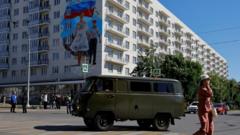In the cities of Ukraine controlled by Russian forces, everyday life is marked by silent resistance and the looming threat of retribution. Nearly a fifth of Ukrainian territory is under Russian occupation, creating a reality where occupants face demands to conform, from acquiring a Russian passport to participating in state-sponsored events. While survival often takes precedence, many Ukrainians continue to challenge the status quo in covert ways—to assert their identity and refuse compliance with imposed governance.
Three Ukrainian individuals from various occupied cities have shared their circumstances with the media. Protecting their identities for safety, we call them Oksana, Viktor, and Alina. In each of their stories, a narrative of life under occupation is woven with threads of fear, resilience, and subtle defiance against an oppressive regime.
Oksana remained in Melitopol during the invasion on February 25, 2022, standing her ground against the occupying forces. She has observed a significant push for Russification, permeating even educational systems, with propaganda infiltrating schools and public spaces. Images circulating on social media reveal a billboard urging local youth to "defend the Motherland," while schoolchildren don military uniforms that symbolize Russian allegiance.
From Mariupol, Viktor describes a city that has been transformed into a shell of its former self. A vital industrial port, Mariupol suffered considerable damage during the invasion, and residents now contend with dwindling job prospects and spiraling living costs. The weight of uncertainty looms large, as discussions of property reclaim and survival fill daily interactions.
Meanwhile, in Crimea, which has faced continuous occupation since 2014, Alina describes a suffocating atmosphere, stripped of Ukrainian identity. Restrictions against the Ukrainian language are pervasive, and public expressions of resistance can draw severe consequences. Alina secretly dons her traditional vyshyvanka during video calls, a symbol of her cultural pride that remains hidden from public view.
As the community faces increasing oppression, threads of an underground resistance weave through these cities. Oksana participates in a covert female movement dedicated to defiance against the occupiers. This group, which operates across different occupied territories, leverages social media to spread messages of support while strategically executing small acts of defiance—such as placing Ukrainian symbols in public spaces or mischievously disrupt terms of occupation.
However, these actions come with significant risks; the threat of detention and even torture hangs over anyone who chooses to oppose the Russian regime openly. Alina expresses the fears surrounding the younger generation, who could harbor violent tendencies fostered by a culture of militarism and oppression.
As they navigate a complex landscape of emotions ranging from hope to dread, the voices of these Ukrainians resonate beyond their confines, seeking recognition and solidarity from those in free territories. Despite their harrowing circumstances, the spirit of defiance endures, fueling dreams of a future liberated from occupation while grappling with the cost of their resistance in the present.
Three Ukrainian individuals from various occupied cities have shared their circumstances with the media. Protecting their identities for safety, we call them Oksana, Viktor, and Alina. In each of their stories, a narrative of life under occupation is woven with threads of fear, resilience, and subtle defiance against an oppressive regime.
Oksana remained in Melitopol during the invasion on February 25, 2022, standing her ground against the occupying forces. She has observed a significant push for Russification, permeating even educational systems, with propaganda infiltrating schools and public spaces. Images circulating on social media reveal a billboard urging local youth to "defend the Motherland," while schoolchildren don military uniforms that symbolize Russian allegiance.
From Mariupol, Viktor describes a city that has been transformed into a shell of its former self. A vital industrial port, Mariupol suffered considerable damage during the invasion, and residents now contend with dwindling job prospects and spiraling living costs. The weight of uncertainty looms large, as discussions of property reclaim and survival fill daily interactions.
Meanwhile, in Crimea, which has faced continuous occupation since 2014, Alina describes a suffocating atmosphere, stripped of Ukrainian identity. Restrictions against the Ukrainian language are pervasive, and public expressions of resistance can draw severe consequences. Alina secretly dons her traditional vyshyvanka during video calls, a symbol of her cultural pride that remains hidden from public view.
As the community faces increasing oppression, threads of an underground resistance weave through these cities. Oksana participates in a covert female movement dedicated to defiance against the occupiers. This group, which operates across different occupied territories, leverages social media to spread messages of support while strategically executing small acts of defiance—such as placing Ukrainian symbols in public spaces or mischievously disrupt terms of occupation.
However, these actions come with significant risks; the threat of detention and even torture hangs over anyone who chooses to oppose the Russian regime openly. Alina expresses the fears surrounding the younger generation, who could harbor violent tendencies fostered by a culture of militarism and oppression.
As they navigate a complex landscape of emotions ranging from hope to dread, the voices of these Ukrainians resonate beyond their confines, seeking recognition and solidarity from those in free territories. Despite their harrowing circumstances, the spirit of defiance endures, fueling dreams of a future liberated from occupation while grappling with the cost of their resistance in the present.




















